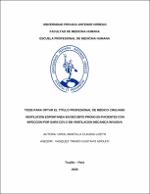Mostrar el registro sencillo del ítem
Ventilación espontanea en decúbito prono en pacientes con infección por SARS- COV-2 sin ventilación mecánica invasiva
| dc.contributor.advisor | Vásquez Tirado, Gustavo Adolfo | |
| dc.contributor.author | Uriol Mantilla, Claudia Lizeth | |
| dc.creator | Uriol Mantilla, Claudia Lizeth | |
| dc.date.accessioned | 2020-10-29T20:51:20Z | |
| dc.date.available | 2020-10-29T20:51:20Z | |
| dc.date.issued | 2020 | |
| dc.identifier.uri | https://hdl.handle.net/20.500.12759/6709 | |
| dc.description.abstract | La infección por coronavirus tipo 2 del síndrome respiratorio agudo severo (SARSCoV-2) causante de la enfermedad por coronavirus 2019 (COVID-19), ha transformado de manera significativa la forma de cómo se practica la medicina hospitalaria en estos últimos 4 meses. Actualmente, existe una gran cantidad de pacientes que ingresan por emergencia a los establecimientos de salud presentando insuficiencia respiratoria que rápidamente evoluciona al estado crítico de la enfermedad, requiriendo en algunos casos el ingreso a la unidad de cuidados intensivos (UCI) y el aporte de ventilación mecánica invasiva (VMI). Se ha llevado a cabo distintas estrategias y métodos para el manejo de pacientes con infección por SARS CoV 2, una de ellas y con mayor relevancia es la posición en decúbito prono (DP), utilizada para mejorar los niveles de oxigenación en pacientes con síndrome de dificultad respiratoria aguda (SDRA). La posición en DP mejora los niveles de oxigenación, disminuyendo el gradiente gravitacional de la presión pleural, mejorando la perfusión y ventilación del parénquima pulmonar, aumentando la capacidad residual funcional y optimizando la relación ventilación/perfusión (V/Q) de los pulmones lesionados. Diversos estudios demuestran el gran beneficio de la posición en DP en pacientes con infección por SARS CoV 2; por lo que actualmente está siendo utilizada como un tratamiento no invasivo para prevenir el deterioro de la función ventilatoria con posterior intubación e ingreso a UCI. | es_PE |
| dc.description.abstract | The severe acute respiratory syndrome type 2 coronavirus infection (SARS-CoV-2) that causes coronavirus disease 2019 (COVID-19) has significantly transformed the way hospital medicine is practiced in these last 4 months. Currently, there are a large number of patients who are admitted to health facilities by emergency presenting respiratory failure that rapidly evolves to the critical state of the disease, requiring in some cases admission to the intensive care unit (ICU) and the provision of ventilation invasive mechanics (IMV). Different strategies and methods have been carried out for the management of patients with SARS CoV 2 infection, one of them and with greater relevance is the prone position (PD), used to improve oxygenation levels in patients with syndrome of acute respiratory distress (ARDS). The PD position improves oxygenation levels, decreasing the gravitational gradient of pleural pressure, improving perfusion and ventilation of the lung parenchyma, increasing functional residual capacity and optimizing the ventilation / perfusion (V / Q) ratio of the injured lungs. Several studies show the great benefit of the PD position in patients with SARS CoV 2 infection; Therefore, it is currently being used as a non-invasive treatment to prevent deterioration of ventilatory function with subsequent intubation and admission to the ICU. | en_US |
| dc.description.uri | Tesis | es_PE |
| dc.format | application/pdf | es_PE |
| dc.language.iso | spa | es_PE |
| dc.publisher | Universidad Privada Antenor Orrego | es_PE |
| dc.relation.ispartofseries | T_MED_2867 | |
| dc.rights | info:eu-repo/semantics/openAccess | es_PE |
| dc.source | Universidad Privada Antenor Orrego | es_PE |
| dc.source | Repositorio institucional - UPAO | es_PE |
| dc.subject | Posición Prona | es_PE |
| dc.subject | Covid- 19 | es_PE |
| dc.title | Ventilación espontanea en decúbito prono en pacientes con infección por SARS- COV-2 sin ventilación mecánica invasiva | es_PE |
| dc.type | info:eu-repo/semantics/bachelorThesis | es_PE |
| thesis.degree.level | Título Profesional | es_PE |
| thesis.degree.grantor | Universidad Privada Antenor Orrego. Facultad de Medicina Humana | es_PE |
| thesis.degree.name | Médico Cirujano | es_PE |
| thesis.degree.discipline | Medicina | es_PE |
Ficheros en el ítem
Este ítem aparece en la(s) siguiente(s) colección(es)
-
Medicina Humana [2739]

